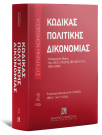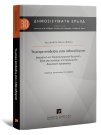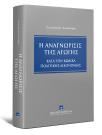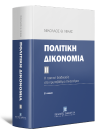F. G. Inchausti/K. Makridou/E. V. García..., Evidence in Spanish and Greek procedural law, 2018
Edition info
Table of contents +-
Series Editors’ ForewOrd
TABLE OF CONTENTS
opening of the conference (by Prof. Constantinos Polyzogopoulos)
TOPIC 1: PRESENTATION OF EVIDENCE
The rules of evidence in Spanish Civil Procedure (by Prof. Dr. Fernando Gascón Inchausti)
1. A short outlook into the Spanish civil justice system: a story of reconstruction
1.1. The starting point
1.2. Main features of the new Code and of the new procedure
1.2.1. Scope
1.2.2. Influences
1.2.3. Overriding principles
1.2.4. Main innovations and structure of declaratory proceedings
2. The rules of evidence of the Spanish civil procedure
2.1. Legal framework
2.2. The scope of evidence
2.3. Types of evidence
2.4. Evaluation of evidence, standard of proof and burden of proof
2.5. Access to information and to evidence
2.6. Presentation and admission of evidence
2.6.1. The roles of the judge and of the parties
2.6.2. Identification, production and proposal of evidence in first instance proceedings
2.6.3. Admission of the evidence to be taken
2.6.4. The issue of illegally obtained evidence
2.6.5. Proposal and taking of evidence in the appeal phase
2.7. Managing the taking of evidence
2.7.1. Time for the taking of evidence
2.7.2. Form
The introduction and presentation of evidence under Greek Law (by Prof. Dr. Kalliopi Makridou)
Ι. General procedural principles governing the introduction and presentation of evidence
Α. Responsibilities of the parties regarding evidence (the principle of the parties’ initiative) - The court’s responsibilities regarding evidence
i) Ordering of evidence
ii) Ordering of additional evidence
Β. The right to be heard in evidence
C. The principle of commonality of evidence
ΙΙ. Introduction and presentation of evidence in first instance proceedings
Α. Special rules governing the use of evidence
i). The use of real evidence
ii). The free and cumulative use of evidence
a) Free use
b) Cumulative use
iii) The inadmissibility of the use of unlawful evidence
Β. The lawful use of evidence - The legislative framework after the recent Law 4335/2015
i) Introduction of evidence with pleadings and addition of subsequent pleadings
a) In ordinary proceedings
b) In special proceedings
ii) The introduction and presentation of written testimony
ΙΙΙ. Introduction and presentation of evidence in second instance proceedings
Α. Introduction and presentation of evidence that was adduced in the first instance proceedings
Β. Introduction and presentation of new evidence
IV. Cassational review of errors committed by the substantive court in respect of the introduction and presentation of evidence
V. Concluding remarks
TOPIC 2: EVALUATION OF EVIDENCE
Evaluation of evidence by the Spanish civil courts (by Prof. Dr. Enrique Vallines García)
I. Introduction
II. Evaluation of evidence
A. Preliminary issues
B. Legal evaluation of evidence
a. General remarks
b. Legal evaluation of documents
(i) Legal evaluation of public documents
(ii) Legal evaluation of official documents
(iii) Legal evaluation of private documents
c. Legal evaluation of party testimony
d. Legal evaluation of non-cooperative party conduct?
C. Free evaluation of evidence
a. General remarks
b. Free evaluation of documents
c. Free evaluation of party testimony
d. Free evaluation of witness testimony
e. Free evaluation of expert evidence
f. Free evaluation of the results of the judicial examination of places, items or persons
D. The principle of ‘procedural acquisition’
E. The principle of ‘overall assessment’ of evidence
III. Presumptions: drawing inferences from indications
A. What is a ‘presumption’?
B. Legal presumptions vs. judicial presumptions
C. Rebuttable presumptions vs. conclusive presumptions
D. Presumptions and the evaluation of evidence
IV. Standard of persuasion
V. Burden of proof
A. Introductory remarks
B. General rules on burden of proof
C. Special rules on burden of proof established by statute
D. Special rules on burden of proof established by agreement of the parties?
E. Special rules on burden of proof created by the court in particular cases based on the principle of ‘availability of evidence and easiness of proof’
F. The application of the rules on burden of proof
VI. Appeals for challenging the fact-findings and the application of the rules on the burden of proof
A. Introductory remarks
B. Review of the fact-findings arising out of the evaluation of evidence and the making of presumptions
C. Review of the application of the rules on the burden of proof
VII. Conclusions
Evaluation of evidence under Greek Law (by Ass. Prof. Dr. Ioannis Delikostopoulos)
I. Introduction
II. Free evaluation of evidence as per article 340 par. 2 of the Code of Civil Procedure.
1. Historical perspective
2. Concept and content of the rule of free evaluation of evidence
i) Conceptual scope of the rule
ii) Free evaluation of evidence and partial free evaluation
iii) Limitations to witness evidence and their exceptions
iv) Applications of the principle of the free evaluation of evidence in various provisions of the CPC
3. The linkage between the free evaluation of evidence by the judge and the generalized equal use of means of evidence that do not satisfy legal requirements
4. Free evaluation of lawful means of evidence
i) General conditions
ii) Limitations on witness evidence and witness statements on oath
iii) Documents
III. Limitations to the rule of the free evaluation of evidence
1. Judicial admission
i) The binding probative power of the judicial admission before the court and the exceptions from full proof
ii) Distinction between judicial and extrajudicial admission
iii) Admission revocation
2. Documents
i) The probative power of public documents
ii) The probative power of private documents
iii) Electronic documents
IV. The linkage between procedural contractual stipulations concerning evidence and the free evaluation of evidence
COMMENTS
The examination of the parties and the role of corporate representatives when testifying at trial (by Dr. Anastasia Vezyrtzi)
Claims for damages, especially for profit loss: evidence under the condition of reasonable probability, as a substantive and procedural rule (by Dr. Evangelia Asimakopoulou)
Exhibition of documents in the field of Greek and Anglo-American law - A comparative approach of the procedural aspects of the institution (by Iordanis Michailidis)
I. The institution of exhibition of documents under Greek civil procedural law
A. General overview of the institution of exhibition of documents
B. Cases of exhibition
C. Request for exhibition
D. Content of the petition
E. Process of exhibition
F. Refusal of exhibition due to contribution of serious cause - Consequences of unreasoned refusal
G. Enforcement of judgments
H. Other procedural methods of assertion of the claim of exhibition of documents.
II. The institution of exhibition of documents in the legal family of Common Law
A. Production of documents under US law
Β. Disclosure of documents under English law
III. Concluding remarks
Affidavits taken abroad, according to Art. 421 Greek CCP (by Eugenia Ferentinou)
Ι. Introductory remarks
ΙΙ. Affidavits taken abroad as an expression of the right of evidence
ΙΙΙ. The issue of a person’s living or residing abroad affidavit before a notary established abroad
1. In general
2. The supported interpretative versions
Α. Τhe affirmative version
Β. The opposite version and own opinion
ΙV. Swearing affidavits via teleconference
SUMMARY AND CONCLUSSIONS
A comparison between the Spanish and the Greek evidence law. Concluding remarks (by Professor Dr. Georgios Diamantopoulos)
Ι. Common fundamental principles relevant to evidence law
ΙΙ. Rules governing the use of evidence in first instance proceedings
Α. The admissible means of evidence
B. Τhe principle of orality and its impact on the efficacy of evidence
C. The identification, production and proposal of evidence in first instance proceedings
ΙIΙ. Rules governing the use of evidence in second instance proceedings
IV. Cassational review of errors committed by the substantive court in respect of evidence
V. Three individual issues relating to evidence: standard of proof, standard of persuasion and burden of proof
VI. The rule of free evaluation of evidence and its limitations
VII. Procedural contractual stipulations concerning evidence
VIIΙ. Final conclusion






















